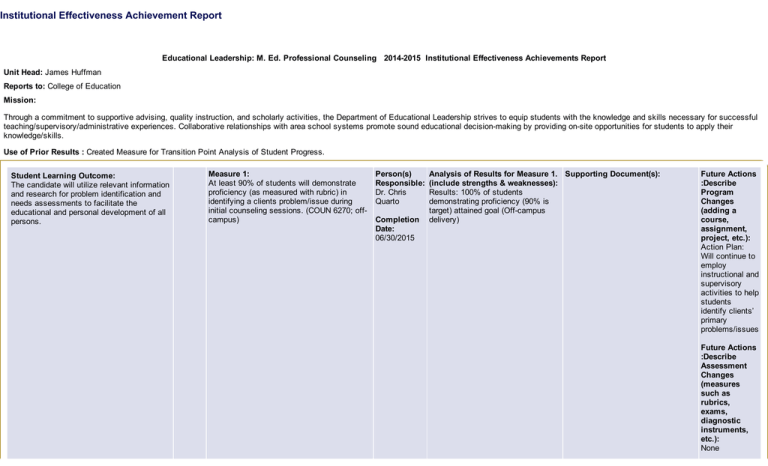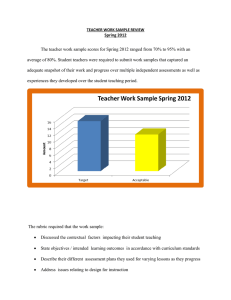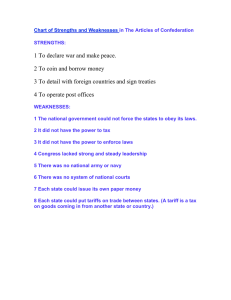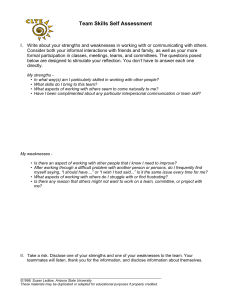Institutional Effectiveness Achievement Report
advertisement

Institutional Effectiveness Achievement Report Educational Leadership: M. Ed. Professional Counseling 2014­2015 Institutional Effectiveness Achievements Report Unit Head: James Huffman Reports to: College of Education Mission: Through a commitment to supportive advising, quality instruction, and scholarly activities, the Department of Educational Leadership strives to equip students with the knowledge and skills necessary for successful teaching/supervisory/administrative experiences. Collaborative relationships with area school systems promote sound educational decision­making by providing on­site opportunities for students to apply their knowledge/skills. Use of Prior Results : Created Measure for Transition Point Analysis of Student Progress. Student Learning Outcome: The candidate will utilize relevant information and research for problem identification and needs assessments to facilitate the educational and personal development of all persons. Measure 1: At least 90% of students will demonstrate proficiency (as measured with rubric) in identifying a client s problem/issue during initial counseling sessions. (COUN 6270; off­ campus) Person(s) Responsible: Dr. Chris Quarto Completion Date: 06/30/2015 Analysis of Results for Measure 1. Supporting Document(s): (include strengths & weaknesses): Results: 100% of students demonstrating proficiency (90% is target) attained goal (Off­campus delivery) Future Actions :Describe Program Changes (adding a course, assignment, project, etc.): Action Plan: Will continue to employ instructional and supervisory activities to help students identify clients’ primary problems/issues Future Actions :Describe Assessment Changes (measures such as rubrics, exams, diagnostic instruments, etc.): None necessary. Future Actions :Describe any additional resources needed (Leave blank if no additional resources are needed.): Measure 2: Unless otherwise noted, Candidates will be evaluated by continuous assessments during their courses. At the transition point (mid­term point), all student performances in a course will be examined to identify weaknesses. Students who are under­performing will be notified. The instructor and student create a plan of improvement to meet required goals by course end. The instructor continues to monitor the student's performance and further steps are taken if needed to foster student success. Reported as percent requiring Transition Point Plan for Improvement. Person(s) Responsible: Dr. Chris Quarto Analysis of Results for Measure 2: (include strengths & weaknesses): Results: 0% of the students required a Transition Point Plan for Improvement. Completion Date: 06/30/2015 Use of Prior Results : Created Measure for Transition Point Analysis of Student Progress Student Learning Outcome: The candidate will integrate relevant theories, perspectives, and reflective discussion in planning and implementing practices aimed at enhancing the educational and personal development of all persons. Measure 1: At least 90% of students will demonstrate proficiency (as measured with rubric) in integrating counseling theories to address a client s problem/issue and providing adequate justification for the theoretical approach. (COUN 6830; on­campus) Person(s) Responsible: Dr. Chris Quarto Completion Date: 06/30/2015 Analysis of Results for Measure 1. (include strengths & weaknesses): Results: 100% of students demonstrating proficiency (90% is target) attained goal (Off­campus delivery) Supporting Document(s): Future Actions :Describe Program Changes (adding a course, assignment, project, etc.): Action Plan: Will continue to employ instructional and supervisory activities to help students integrate counseling theories and provide justification for theoretical approaches. Future Actions :Describe Assessment Changes (measures such as rubrics, exams, diagnostic instruments, etc.): None Necessary. Future Actions :Describe any additional resources needed (Leave blank if no additional resources are needed.): Measure 2: Unless otherwise noted, Candidates will be evaluated by continuous assessments during their courses. At the transition point (mid­term point), all student performances in a course will be examined to identify weaknesses. Students who are under­performing will be notified. The instructor and student create a plan of improvement to meet required goals by course end. The instructor continues to monitor the student's performance and further steps are taken if needed to foster student success. Reported as percent requiring Person(s) Responsible: Dr. Chris Quarto Completion Date: 06/30/2015 Analysis of Results for Measure 2: (include strengths & weaknesses): Results: 0% of the students required a Transition Point Plan for Improvement. Transition Point Plan for Improvement. Use of Prior Results : Created Measure for Transition Point Analysis of Student Progress Student Learning Outcome: The candidate will analyze critical data and professional sources to facilitate his or her development as a learner, practitioner, and researcher (or consumer of research). Measure 1: At least 90% of students will demonstrate proficiency (as measured with a rubric) in gathering sources and critically analyzing information contained in those sources to address a topic for a literature review paper (COUN 6110; off­campus) Person(s) Responsible: Dr. Chris Quarto Completion Date: 06/30/2015 Analysis of Results for Measure 1. (include strengths & weaknesses): Results: 100% of students demonstrating proficiency (90% is target) attained goal (Off­campus delivery) Supporting Document(s): Future Actions :Describe Program Changes (adding a course, assignment, project, etc.): Action Plan: Will continue to require students to gather sources and critically analyze information for research papers. Future Actions :Describe Assessment Changes (measures such as rubrics, exams, diagnostic instruments, etc.): None necessary. Future Actions :Describe any additional resources needed (Leave blank if no additional resources are needed.): Measure 2: Unless otherwise noted, Candidates will be evaluated by continuous assessments during their courses. At the transition point (mid­term point), all student performances in a course will be examined to identify weaknesses. Students who are under­performing will be notified. The instructor and student create a plan of improvement to meet required goals by course end. The instructor continues to monitor the student's performance and further steps are taken if needed to foster student success. Reported as percent requiring Transition Point Plan for Improvement. Person(s) Responsible: Dr. Chris Quarto Analysis of Results for Measure 2: (include strengths & weaknesses): Results: 0% of the students required a Transition Point Plan for Improvement. Completion Date: 06/30/2015 Use of Prior Results : Created Measure for Transition Point Analysis of Student Progress Student Learning Outcome: The candidate will analyze and reflect on formal and informal assessment strategies in order to make connections between instruction (or practice), learning, and assessment. Measure 1: At least 90% of students will demonstrate proficiency in using a solution­focused scaling question to assess client progress in counseling and recording the client s responses to the question in progress notes at the conclusion of each counseling session. Proficiency will be determined by whether a) the student consistently recorded the client s self­reported ratings in progress notes and b) the client made progress in achieving a goal as reflected in the ratings. (COUN 6270; off­ campus) Person(s) Responsible: Dr. Chris Quarto Completion Date: 06/30/2015 Analysis of Results for Measure 1. (include strengths & weaknesses): Results: 100% of students demonstrating proficiency (90% is target) attained goal (Off­campus delivery) Supporting Document(s): Future Actions :Describe Program Changes (adding a course, assignment, project, etc.): Action Plan Will continue to require students to implement scaling technique in counseling sessions and record information in clients’ files as a measure of client progress. Future Actions :Describe Assessment Changes (measures such as rubrics, exams, diagnostic instruments, etc.): None necessary. Future Actions :Describe any additional resources needed (Leave blank if no additional resources are needed.): Measure 2: Unless otherwise noted, Candidates will be evaluated by continuous assessments during their courses. At the transition point (mid­term point), all student performances in a course will be examined to identify weaknesses. Students who are under­performing will be notified. The instructor and student create a plan of improvement to meet required goals by course end. The instructor continues to monitor the student's performance and further steps are taken if needed to foster student success. Reported as percent requiring Transition Point Plan for Improvement. Report Date: Fri Aug 14 2015 11:05:59 CDT Person(s) Responsible: Dr. Chris Quarto Completion Date: 06/30/2015 Analysis of Results for Measure 2: (include strengths & weaknesses): Results: 0% of the students required a Transition Point Plan for Improvement. Close





